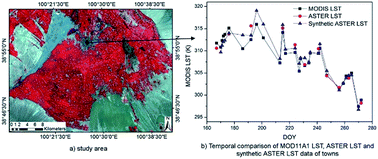Generating daily high spatial land surface temperatures by combining ASTER and MODIS land surface temperature products for environmental process monitoring
Abstract
There is a shortage of daily high spatial land surface temperature (LST) data for use in high spatial and temporal resolution environmental process monitoring. To address this shortage, this work used the Spatial and Temporal Adaptive Reflectance Fusion Model (STARFM), Enhanced Spatial and Temporal Adaptive Reflectance Fusion Model (ESTARFM), and the Spatial and Temporal Data Fusion Approach (STDFA) to estimate high spatial and temporal resolution LST by combining Advanced Spaceborne Thermal Emission and Reflection Radiometer (ASTER) LST and Moderate Resolution Imaging Spectroradiometer (MODIS) LST products. The actual ASTER LST products were used to evaluate the precision of the combined LST images using the correlation analysis method. This method was tested and validated in study areas located in Gansu Province, China. The results show that all the models can generate daily synthetic LST image with a high correlation coefficient (r) of 0.92 between the synthetic image and the actual ASTER LST observations. The ESTARFM has the best performance, followed by the STDFA and the STARFM. Those models had better performance in desert areas than in cropland. The STDFA had better noise immunity than the other two models.


 Please wait while we load your content...
Please wait while we load your content...